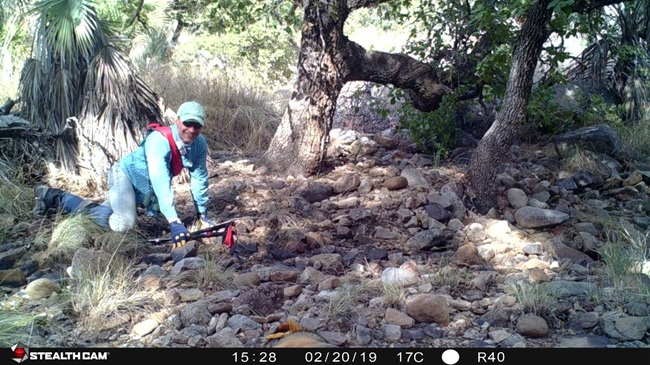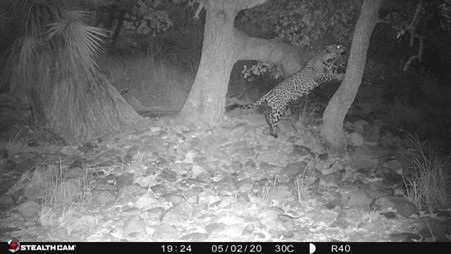The Northern Jaguar Project
The Mexican state of Sonora is the northernmost current natural range of the jaguar (Panthera onca). Here, we are supporting the acquisition of contiguous cattle farms and turning them into jaguar habitat. The Northern Jaguar Reserve and Northern Jaguar Project was established, but this sizeable land cannot function as jaguar habitat without the collaboration of the adjoining cattle farms. The jaguars historically were killed here by contracted bounty hunters for 5,000 pesos (approx. $415AUD) each to protect the cattle. The neighbouring landowners were invited to join the project by signing a memorandum that they won’t kill jaguars and won’t hunt their prey (deer, capybara, etc.). In return, their farms were equipped with camera traps.

Figure 1. Posing at jaguar height for the camera trap as it is set, hoping to catch jaguars as they roam. Credit: Northern Jaguar Project.

Figure 2. It worked. Credit: Northern Jaguar Project.
Every camera trap sighting of a jaguar credits exactly 5000 pesos to the landowner and they have the naming right for the newly sighted jaguar. Three pictures a year is enough to provide feed for the cattle in a bad year. The local farmers quickly worked out that one jaguar can make many times over the 5000 pesos if they do not get shot. By naming individual jaguars after family members the chance of an assassination became even less likely! The land has just enough game to maintain the jaguars in balance, which the farmers recognised in retrospect; “every time I shot a deer, soon I lost a calf from predation”. Saving their natural prey helped makes the jaguar uninterested in cattle. Focusing on the preservation of the apex predator’s habitat also had a huge positive downstream effect on four other wild cat populations (puma, bobcat, ocelot and jaguarondi) and the rest of the flora and fauna of this 56,000 acre reserve. An example of how focusing on the keystone species benefits all wildlife.
WildPlains
WildPlains (
Wild Plains Conservation Project) is a small central European grassland and wetland reserve, which was established as a buffer zone for the adjacent national park from marginal agricultural land of miserable yield with excessive fertilisation and pesticide use. After the abandonment of farming and the introduction ultra-low intensity grazing with the proxies of the extinct megafauna, the land bounced back in biodiversity providing habitat for many species not seen for a long time and allowed the documentation of 219 bird species.
 Figure 3
Figure 3. A young male roe deer (Capreolus capreolus) enjoys safety on WildPlains.
Credit: Zsolt Balogh
 Figure 4
Figure 4. Bank swallows (Riparia riparia) established a 200-strong colony on WildPlains where they have not been observed for at least 50 years. Credit: Zsolt Balogh.
COBRA
COBRA (
Curricabark Open air Biodiversity Restoration laboraAtory) is a recently established reserve for perpetuity and approved by the Biodiversity Conservation Trust. It was cleared about 150 years ago and had been grazed ever since. It’s new role is to provide a wildlife corridor between two national parks and a refuge to the endangered brush-tailed rock wallaby (Petrogale penicillata), which is not as well-known marsupial as the koala, but just as endangered as we have only about half as many of them left in the wild. The project also serves as a training site for the traditional custodians of the land for cultural burning practices to teach future generations. Watch the '
Cultural Burning at Curricabark: Walking together in conservation' video for more information on this cultural burn workshop and how it improves habitat conditions for native fauna.
 Figure 5
Figure 5. Brush-tailed rock wallaby (Petrogale penicillata) is not
en-danger on COBRA. Credit: Rye Gollan.
Depending on your ability, you can make your activity smaller by turning your courtyard into an indigenous
micro-forest or acquire up to two per cent of the landmass of Chile and donate it to the government through
Tompkins Conservation but the concept is the same: active, individual, measurable impact towards the preservation of our natural world.
Acknowledgements
Zsolt Balogh for his dedication and enormous efforts on WildPlains and Rye Gollan for his expertise and support for COBRA.